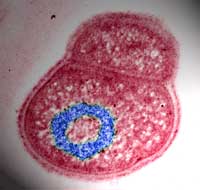Life Sciences and Chemistry
Articles and reports from the Life Sciences and chemistry area deal with applied and basic research into modern biology, chemistry and human medicine.
Valuable information can be found on a range of life sciences fields including bacteriology, biochemistry, bionics, bioinformatics, biophysics, biotechnology, genetics, geobotany, human biology, marine biology, microbiology, molecular biology, cellular biology, zoology, bioinorganic chemistry, microchemistry and environmental chemistry.

From sardines to anchovies and back in 50 years
Local fisheries part of bigger cycle affecting entire Pacific Ocean
In the late 1930’s, California’s sardines supported the biggest fishery in the western hemisphere, with more than half a million tons of fish caught each year. By the mid-1950s, the sardines had virtually disappeared. Although fishing pressure may have played a part in this process, new research published in the current issue of Science indicates that the sardines’ demise was part of a 50-year cycle tha

Radiation-resistant organism reveals its defense strategies
The secret to its strength is a ring, Weizmann Institute researchers report in Science
Weizmann Institute scientists have found what makes the bacterium Deinococcus radiodurans the most radiation-resistant organism in the world: The microbe’s DNA is packed tightly into a ring. The findings, published in the January 10 issue of Science, solve a mystery that has long engaged the scientific community.
The red bacterium can withstand 1.5 million rads – a thousand times more tha

For Determining Protein Structures, A New Method Boosts Precision and Speed in High-Dimensional NMR
A University at Buffalo chemist has developed a new, high-throughput method for obtaining nuclear magnetic resonance (NMR) data that not only has the distinction of potentially performing orders of magnitude faster than conventional methods, but does so more cheaply and with greater precision.
The new method, described in the current online issue of the Journal of the American Chemical Society, has the potential to increase greatly the use of high-throughput NMR to determine protein structu

Scientists find first active ’jumping genes’ in rice
University of Georgia researchers studying rice genomes under a National Science Foundation Plant Genome Research Program award have identified the species’ first active DNA transposons, or “jumping genes.” The research is published in the Jan. 9 edition of the journal Nature. In collaboration with researchers from Cornell, Washington University and Japan, geneticist Susan Wessler also discovered the first active “miniature inverted-repeat transposable element,” or “MITE,” of a

UNC studies target molecular defects implicated in cancer, genetic diseases
In three separate studies, scientists at the University of North Carolina at Chapel Hill School of Medicine have shown that it is possible to correct defective molecular splicing pathways that would otherwise contribute to cancer, genetic diseases and possibly other disorders.
These corrections were accomplished by the insertion into the cell of antisense oligonucleotides, short strands of genetic material that target portions of RNA. RNA carries the DNA blueprint for cellular protein produ

Sirtuin protein has a new function; May play role in lifespan extension
Scientists from Johns Hopkins and the University of Wisconsin have discovered that a protein called Sir2, which is found in nearly all living cells, has a new function that might help explain how calorie restriction can increase lifespans for some animals, the scientists say. Their report appeared in the Dec. 20 issue of Science.
A number of laboratories have shown that restricting total calorie intake extends the lifespans of organisms ranging from yeast to laboratory animals. Others have